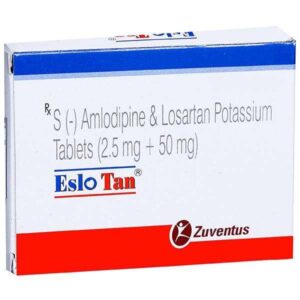LOSARTAN + AMLODIPINE
Losartan: Losartan is a medication used primarily to treat high blood pressure and certain types of heart conditions, such as heart failure. It belongs to a class of drugs known as angiotensin II receptor blockers (ARBs). Losartan works by blocking the action of angiotensin II, a hormone that narrows blood vessels and causes the release of another hormone called aldosterone, leading to increased blood pressure.
By blocking the effects of angiotensin II, Losartan helps to relax and widen blood vessels, allowing for easier blood flow and reducing blood pressure. It also helps to reduce the workload on the heart, making it an effective treatment for heart failure.
The typical dose of Losartan for adults with high blood pressure is usually 50 mg taken once daily. However, individual dosages may vary depending on the patient’s condition and response to treatment. In some cases, the dose may be increased to a maximum of 100 mg per day. For heart failure, the starting dose is usually 12.5 mg once daily, which may be increased gradually under medical supervision.
As with any medication, Losartan may cause some side effects. Common side effects include dizziness, fatigue, headache, and stomach upset. Some individuals may also experience cough, nasal congestion, or flu-like symptoms. While rare, more serious side effects can include allergic reactions, rapid heartbeat, and kidney problems. It’s important to consult with a healthcare professional if any concerning side effects occur.
Losartan is generally considered safe and effective for most people, but it may not be suitable for individuals with a history of hypersensitivity to the drug or those who have experienced angioedema (swelling of the face, lips, tongue, or throat) while taking it. It is important to inform your healthcare provider about any existing medical conditions or medications you are taking before starting Losartan to ensure its safe and appropriate use.
Amlodipine: Amlodipine is a prescription medication that belongs to a class of drugs known as calcium channel blockers. It is primarily used to treat high blood pressure (hypertension) and certain types of chest pain called angina.
The mechanism of action of amlodipine involves blocking the entrance of calcium into the smooth muscle cells of blood vessels and the heart, which results in relaxation and widening of the blood vessels. This helps to reduce blood pressure and increase blood flow to the heart, alleviating symptoms of angina.
The usual starting dose of amlodipine for hypertension is 5 mg once daily, and it can be increased to a maximum dose of 10 mg once daily if needed. For the treatment of chronic stable angina or vasospastic angina, the usual dose is 5-10 mg once daily.
Like any medication, amlodipine may cause some side effects. Common side effects may include dizziness, flushing, headache, edema or swelling of the ankles or feet, and abdominal pain. Some individuals may experience more serious side effects, such as irregular heartbeat, chest pain, severe dizziness, or fainting, which should be promptly reported to a healthcare professional.
It is important to note that amlodipine can interact with other medications, such as certain antibiotics, antidepressants, and antifungal drugs, so it is crucial to inform your healthcare provider about all the medications you are taking.
Overall, amlodipine can be an effective medication for managing high blood pressure and angina. However, it should be taken under the guidance of a healthcare professional, and any concerns or questions regarding its use should be discussed with a doctor or pharmacist.

